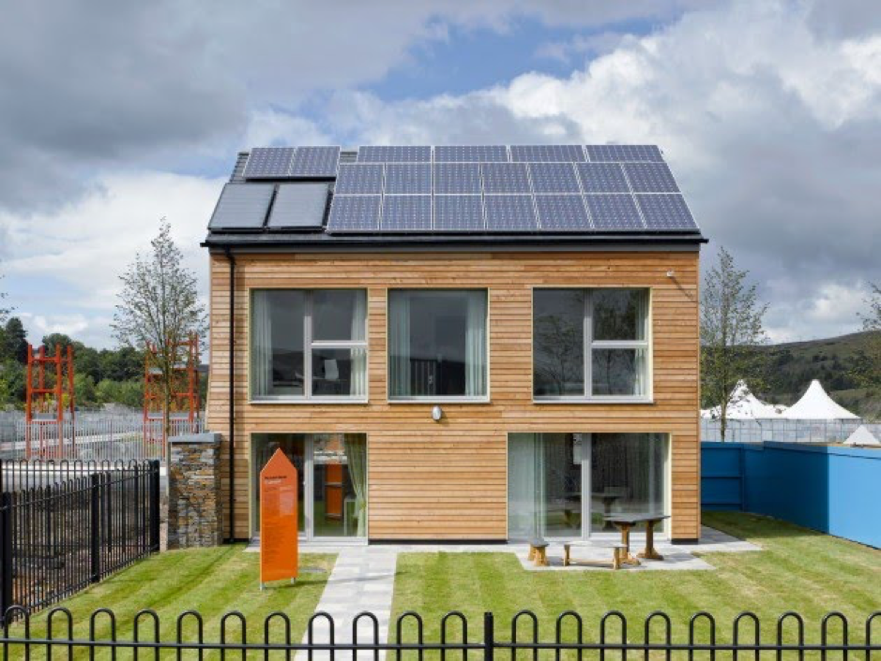Building a house with recycled materials is already a reality and there are more and more people who are betting on this alternative. Specifically, an eco-sustainable house is built with recycled materials and it has a renewable or environmentally friendly energy supply.
There is not just one ecological house, but many possible ones that will vary according to the particular conditions of the place where it is located and of those who will inhabit it. These can be built in any area, as long as the land and the building meet the appropriate conditions. From the aspect of its natural environment, the aim will be to take advantage of the possibilities offered by the habitat, taking into account: orientation, control and use of the sun, control and use of the wind, and obtain a good quality of views. For this reason, when building an ecological house it is fundamental to deepen the knowledge of its environment. The main objective is to build a house with the common characteristics (bedrooms, bathrooms, kitchen, living room ...) but that is self-sufficient. That is to minimize its impact on the environment, allowing sustainable development, generate their own resources, and achieve harmony with the habitat in which it is located.
For example, in third world countries or underdeveloped countries, there are houses that are environmentally friendly and could help make better use of resources. But ecological houses are increasingly in demand in the developed world. A home in which to forget about pollution from outside and where to make the most of energy without destroying the environment and the planet's resources. The following image shows an example of an eco-house:

Having self-sufficient ecological houses can have many advantages for their owners and for the natural environment, such as the following:
On the one hand, they represent significant savings, both in construction and in long-term spending. The use of natural or recycled materials such as wood, straw, lime, stone, bamboo, sheep's wool, compressed earth blocks, cork and with advanced technologies (solar panels, intelligent heating system, natural ventilation), reduces costs. Although it is thought that ecological buildings are more expensive, this is not the case. The design and construction of green structures costs approximately the same as other types of buildings. And if they are more expensive, you save a lot of money on energy and maintenance in the long run, so you gain over time.
Therefore, the use of ecological materials, apart from reducing costs, increases the durability of the house, as natural materials are usually much more resistant than those that are "artificial", which results in lower maintenance costs. For example, most green buildings do not require exterior painting as often.
The ecological houses contribute to the respect to the environment and therefore, they contribute their grain of sand for the health and the well-being, because natural materials, free of toxins are used. These houses do not pollute, nor do they waste energy, but the opposite, they offer a comfortable space that fully respects the environment and has a real impact on our health.
Despite having these advantages in terms of savings, energy efficiency and respect for health and the environment, it is also true that not everyone has access to creating a totally ecological home and many times we are limited by where we live.
Green buildings may need, for example, a certain location for energy saving, so that the windows are oriented towards the place where there is more sun and more heat, in order to take advantage of this natural energy source. The environment is also important, because the existence of trees will have to be taken into account to protect the house from the sun in summer. It is also possible to regulate the interior climate of the house in an efficient way, through the large windows, the currents and the convection of the air due to the difference in temperature. To do this, it is important to have a good insulation in the house.
As I mentioned before, a sustainable house is built with natural materials that respect the environment. They must be materials that facilitate transpiration and isolate from noise and outside temperature. However, many of these special materials are difficult to find and transport costs can be high. So, this can make the phases of an eco-home construction site longer.
Currently, we are living in a century where world trends point to sustainable and environmentally friendly development. The mentality of consumers is changing and it is increasingly important and recognized by people to be a contribution to halt the deterioration of ecosystems. In short, the growing environmental awareness of consumers has led to the emergence of a new market that the company must satisfy with an ecological offer suitable to their needs.
The potential client of these ecological houses is the type of family that requires the concept of ecology, that feels taste for the nature and where the renewable energies stand out, allowing that the house is autonomous and does not depend for example on the local network, through the use of solar collectors for sanitary hot water and of photovoltaic modules for electricity, if desired
In conclusion, saving money and protecting the environment have become the priorities of many people when it comes to building a home, that is why in recent years self-sufficient ecological housing has had a great boom and has become a way of living much more respectful and integrated with the nature around us.